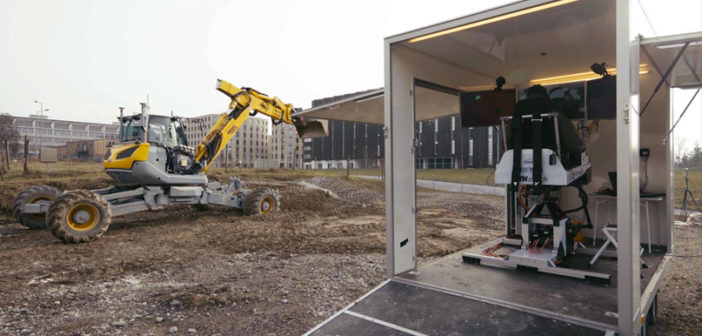Leica Geosystems develops fully autonomous excavators with Menzi Muck and the Robotic Systems Lab from the ETH Zürich in Switzerland.
Author: Karina Lumholt
Automation and robotics technology are new drivers in many industries, although, heavy construction is one of the least digitalised sector worldwide, lacking digitalisation and adoption of new technology.
Latest innovations can shake things up in the construction sector, including automation technology. Leica Geosystems is participating in a research project together with the Swiss excavator manufacturer, Menzi Muck and the Robotic Systems Lab from the University of Zürich, ETH Zürich, for the development of an autonomous walking excavator.

Simon Kerscher from the University of Zürich has been working on the robotic excavator for one year.
Simon Kerscher, robotic systems engineer at ETH Zürich, has been working on the project for a year and highlighted some of the tasks an autonomous excavator can be used for:
- Driver assistance – can make the operation of the excavator easier.
- Teleoperation – when you are working in unsafe, difficult or even dangerous terrain such as fresh mudslides, avalanche-prone areas, or land mine areas.
- Fully autonomous excavators – the primary autonomous use cases are robotic landscaping and autonomous excavating of difficult contours.
“Humans are very good at making very flat surfaces but can’t really do anything else,” explains Kerscher.
Teleoperating excavators thanks to machine control
For the research project, Leica Geosystems provided the machine control solution, the Leica iCON iXE3, providing information about the exact location of the excavator’s bucket. “We use the machine control solution to implement controls for teleoperation of the machine, making it easier for the driver to navigate the bucket. The operator can move the bucket directly in space instead of actuating the joints,” explains Kersher.

Leica Geosystems participates in the research project of developing an autonomous excavator.
Menzi Muck is a company founded by the entrepreneur Ernst Menzi, who invented the walking spider excavator in 1966. The walking excavator is designed for all-terrain, heavy-duty work on slopes and has long legs on wheels instead of belts, which makes it suitable for work on slopes or in deep water.
“This project shows our commitment to further develop the automation of the excavator that will help less experienced machine operators to get up to speed with more experienced drivers and avoid costly rework,” explains Marcus Grevelshøj, product manager for excavator solutions at Leica Geosystems.
The market trend clearly shows a need for more automated machine control solutions. New technology opens up completely new applications to dramatically improve productivity and safety in the heavy construction industry.














